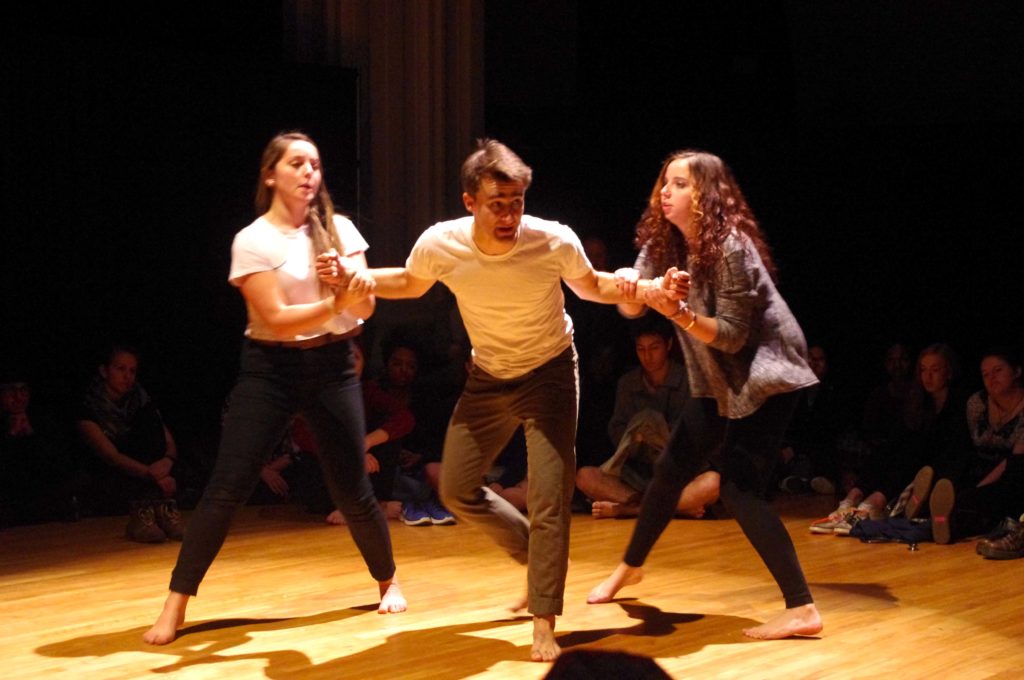By Liam Hofmeister, inside editor
Two performers wrestled Dario Sanchez, a third-year communications major, to the ground and stripped him of his clothes. His skin was covered with words written in marker. The words were the labels that others have put on him about his race.
“I’m passing as brown, and I’m passing as white,” Sanchez said, undressed of his layers and standing in his purple underwear before an audience of nearly 100 people.
Sanchez’s presentation was just one of 17 pieces presented on Oct. 10 at Northeastern University’s Fenway Center in “Body Maps,” a collection of student-written and performed stories about personal histories, passions and identities. For one week, students from Northeastern and the School of the Museum of Fine Arts spent their evenings working with Tim Miller, a Northeastern artist-in-residence, performance artist and activist.
“The room was exploding with real risk-taking… funny, sexy performance,” Miller said. “It [was] five workshops for an hour-long performance. I know it’s not supposed to be possible, but I knew that it was.”
“Body Maps” began at the doors of the Fenway Center. Performers guided audience members in pairs of two and showed them their body maps, personally designed images representing how the performers view their bodies.
“I imagine that our bodies carry emotions and stories,” Miller said.
Some body maps looked like cubist reconstructions of a body as noses, arms and legs were magnified and shifted in the pictures. Other maps were simply torn to shreds.
The audience was then guided to sit in a circle, framing a new stage for the performers. The actors sat among the audience and entered the stage when it was time to tell their story.
Sam Mulcahy, a sophomore theater major and “Body Maps” performer, laid himself in the center of the stage.
“Scalpel,” he said as he pantomimed slicing his chest open to remove the pieces left behind by his ex-girlfriend.
Another actor, sophomore theater major Jamez Anderson, began her piece as if she were jumping, singing and dancing at a party. The scene quickly shifted, however, to an all-out bashing of objectification in college hookup culture.
“A body, is that all that we are?” she said. “For you to do what you want?”
“Body Maps” ended with all of the actors standing together on stage, inhaling and exhaling in unison.
“In rehearsal, we would sit in a circle, hold each other’s hands and just breathe,” Anderson said, a gesture to show that each participant supported one another.
Performers tackled topics ranging from sexuality to mental illness and body-image insecurity.
“You really are out on a limb doing your own solo-devised piece,” Jesse Hinson, assistant teaching professor in the Northeastern Theatre Department and one of Miller’s former students, said. “And the fact that he was only here for a week, it kind of puts the top on a pot of boiling water. It makes [performances] have to boil.”
On Oct. 8, Miller put on a performance of his own at the Studio Theatre in Ell Hall to preface “Body Maps.” The piece, titled “Sex/Body/Self,” was a collection of anecdotes from Miller’s life as a gay adolescent.
Miller detailed how, when he was 9 years old, he told another little boy he would marry him. In another story, he spoke about a belligerent group of men from Montana throwing a bottle of Colt 45 liquor at him for being gay. Miller finally recounted how he felt after being legally married in his city’s clerk’s office, a place he had historically been brought to be arrested for his activism efforts.
Miller believes that the stories from life’s hardships are the ones worth telling to bring change.
“We value and encourage [deeply personal] work more and more in our theaters,” Miller said. “If we want specific work, it’s going to be [up to] us to make it happen.”
In her overall experience, Anderson felt that “Body Maps” brought her a new appreciation for the work an individual can make.
“The work we made with Tim was very emotional,” she said. “I don’t think I’ll ever have another storytelling experience like this in my life.”
Photo courtesy Thomas Vannatter, Northeastern University Center for the Arts















